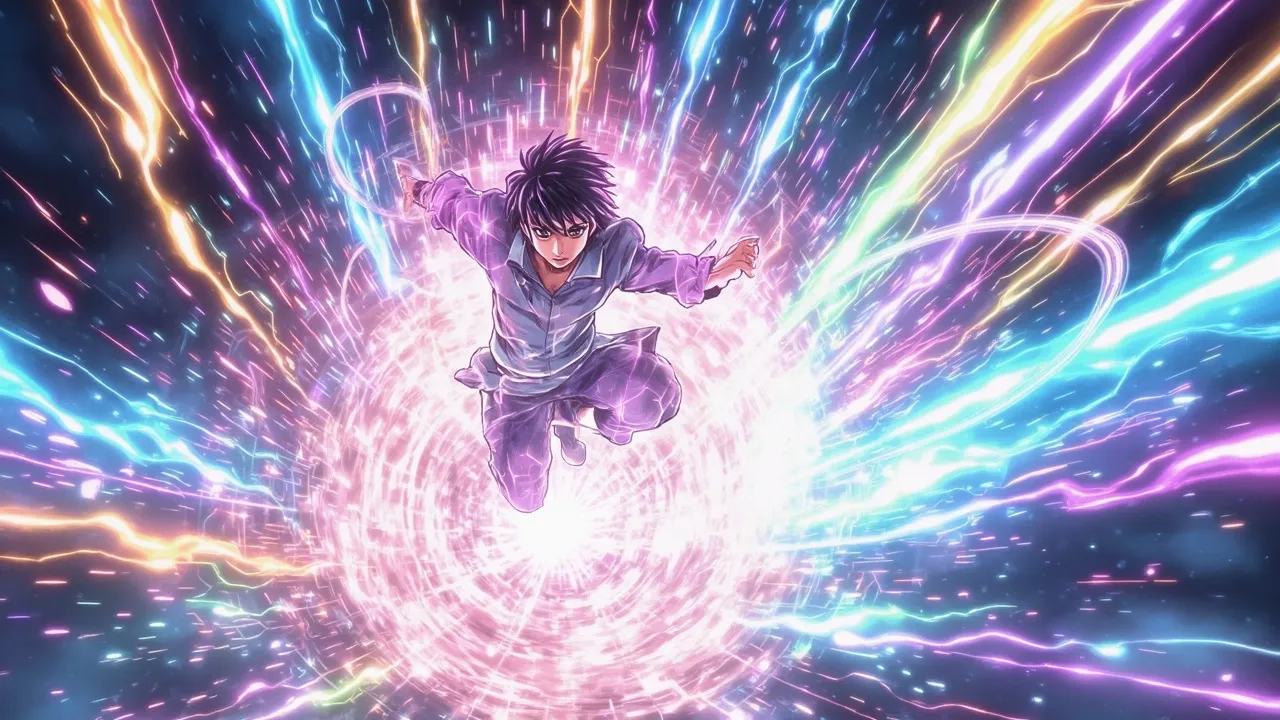Prismatic Veil

Prismatic Veil Video Demo 🎬
Table of Contents
Prismatic Veil is a light-based superpower that bends, refracts, and scatters visible and near-visible spectra to create spectral shielding, stealth, and deception. By controlling photonic pathways—refraction, diffraction, and polarization—the user crafts dynamic defenses, cloaks, and illusions in real time. As a cousin to photokinesis and light manipulation, this power excels in battlefield control, protective barriers, and misdirection, while also offering reconnaissance capabilities and team utility. For more abilities like this, explore the growing archive in the superpower wiki, or discover unexpected concepts with the random superpower generator.
What Is Prismatic Veil
Prismatic Veil is the controlled shaping of light to generate layered, semi-solid optical structures. These structures include rainbow-like barriers, refractive cloaks, kaleidoscopic decoys, and polarized screens that filter or absorb incoming energy. Unlike pure illusion casting, the veil can incorporate photon pressure, lensing, and partial energy dispersion—allowing it to block, soften, or redirect physical and energy-based attacks. In essence, the user creates mobile “glasswork” out of air: panels, domes, and ribbons formed from controlled refractive indices and micro-prisms, all tuned to the ambient environment.
Because the veil manipulates both intensity and pathway, it can produce invisibility, camouflage, and holographic projections. When tuned to non-visible bands (UV, IR), it can also confuse sensors and targeting systems, making it relevant in modern or sci-fi settings. This places the power at the intersection of stealth, shielding, and battlefield information warfare.
Core Abilities of Prismatic Veil
Spectral Shielding
A primary feature is the rainbow barrier—an arcing layer of refracted light that disperses kinetic and energy attacks. By splitting incoming beams into component wavelengths and redirecting them, the veil reduces damage like a tactile energy shield. Against projectiles, the veil can induce micro-mirage effects that nudge trajectories off target. Against lasers or plasma, the user polarizes and defocuses beams, spreading energy across a larger area to prevent penetration.
Refractive Camouflage and Invisibility
By matching and continuously adjusting the refractive index of space around them, the user bends light around their body or an ally. This renders the target translucent to invisible, similar to advanced optical cloaks. The effect is strongest when the environment is stable and lighting is predictable. In urban or indoor spaces with mixed lighting, refined control can still achieve near-invisibility via dynamic recalibration.
Spectral Illusions and Holography
The user projects photorealistic duplicates, mirage corridors, or terrain overlays. These illusions exploit depth cues, parallax, and polarization to fool both human sight and some machine sensors. Unlike conventional glamour, Prismatic Veil illusions can incorporate physical glare, shadowing, and atmospheric scattering for high fidelity. The user can even create directional illusions visible only from certain angles, tricking snipers, drones, or security cameras.
Prismatic Armor
A thin multi-layer glaze coats the user’s suit or skin, acting like flexible glass platelets. This prismatic armor can harden momentarily to absorb blunt force, or stay elastic to deflect cutting edges. It also reduces thermal signatures by spreading heat emission across bands, offering partial protection against thermal tracking and heat-based attacks.
Light Lensing and Field Control
The veil focuses light into tight columns for temporary blinding flashes, or unfocuses light to dim a zone. Selective polarization can mute laser sights, camera lenses, or heads-up displays. In reconnaissance, subtle lensing magnifies distant scenes or reads micro-expressions without physical equipment.
Counter-Sensor Cloaks
Beyond the eye, Prismatic Veil influences near-visible bands. The user can smear IR signatures across an area or bounce UV to erase traces. While not perfect against all scanning methods, it reliably confuses basic motion detectors, rangefinders, and optical tracking.
Application / Tactical Advantages in Combat
Prismatic Veil shines in asymmetric engagements and urban combat. In open fields, the user erects layered shields and false silhouettes to fragment enemy cohesion. In corridors, reflective “maze walls” appear, slowing advances and turning corners into killboxes. Decoys peel off in multiple directions, forcing adversaries to split fire. Spectral flashbursts blind or disorient, creating a window for repositioning.
Defensively, stacked veils redirect incoming fire while coloring the battlefield with telltale bands; the hue gradient doubles as a feedback system—deeper violet indicates high energy absorption, warning the team to rotate positions. Offensively, bright micro-prisms thrown like cards can act as flare-traps: when struck by energy, they bloom into glare blooms and confuse targeting.
Outside combat, the user becomes a scout and infiltration specialist. Refractive camouflage bypasses patrols. Holographic overlays hide doors, disguise equipment, and project false crowds to mislead surveillance. The power’s flexibility also lends itself to rescue missions, masking evac routes and shielding civilians with broad umbrella veils.
Level: Level 1 🏙️, Level 2 🌇, Level 3 🌃
Level 1 🏙️ — Novice Refraction

At the entry tier, the user creates thin panels and short-duration cloaks. Camouflage is partial—more a shimmer than full invisibility—and motion breaks the effect with a ripple. Shields can deflect small projectiles and attenuate low-power energy beams but struggle with sustained fire. Illusions are static stills or looping silhouettes. Practical uses include quick cover, brief peeks around corners via lensing, and emergency glare flashes. Training focuses on stable shapes, recognizing ambient light patterns, and learning to “read” the room’s spectral composition.
Level 2 🌇 — Advanced Spectral Weaving

The user weaves multi-layer veils with variable hardness and polarization. Full invisibility becomes possible when stationary; movement leaves only faint distortions. Rainbow barriers can disperse mid-caliber ballistics and resist one or two direct energy strikes. Illusions gain parallax and ambient shadow fidelity, capable of fooling human observers and basic cameras. Prismatic armor can be flex-hardened at impact, reducing blunt trauma. At this tier, counter-sensor cloaks disrupt thermal and UV tracking in controlled environments. The user can maintain a mobile “bubble shield” while guiding a small team through hostile zones.
Level 3 🌃 — Master of the Spectrum

At mastery, Prismatic Veil can bend complex lighting in chaotic conditions: flickering neon, smoke, rain, and strobe. The cloak works in full motion, with only rare artifacts. Spectral shielding withstands heavy ballistic barrages and diffuses high-energy beams by splitting, phase-shifting, and redirecting them through nested prisms. Illusions are cinematic, real-time, and viewpoint-aware; the user can make a street appear evacuated or reshape a warehouse interior. Prismatic armor integrates micro-lenses that convert impact energy into brief light blooms, then vent it harmlessly. Master users create corridor-length light tunnels to channel enemies, blind drones without harming human eyes, and write data into the air as hard-to-intercept optical code.
Limitations of Using the Prismatic Veil
-
Energy and Focus Drain
Light shaping requires constant calculation. Long engagements tax concentration and can cause headaches, visual snow, or afterimages. Drifting focus destabilizes the veil, producing telltale ripples that reveal position. -
Environmental Dependence
While the veil can amplify existing light, total darkness or overpowering glare complicates precise control. Smoke and fog scatter light unpredictably; skilled users can exploit this, but novices will see cloaks flicker and shields thin. -
Angle of Incidence Vulnerability
The veil’s effectiveness varies with angle. Attacks arriving from unanticipated vectors may hit at suboptimal refraction angles, slipping through or stressing the barrier where layers are thinnest. -
Thermal Load
Refracting and absorbing energy generates heat. Prolonged beam dispersion can overheat the veil, forcing cooldowns. Failure to vent heat may cause “spectrum collapse,” where panels shatter into bright, useless glare. -
Sensor-Diverse Adversaries
Opponents using radar, sonar, or psionic detection bypass many visual tricks. Likewise, highly advanced multi-band sensors that combine optical with LIDAR or hyperspectral imaging can spot inconsistencies. -
Material Interference
Certain metamaterials and matte surfaces absorb or scatter light in ways that resist lensing. Blackbody coatings, anti-laser paints, and chaotic micro-textures can degrade camouflage and shield efficiency.
Weakness Against What Other Superpowers
-
Shadow Manipulation
Masters of darkness can dampen or steal ambient light, leaving the veil starved. In deep umbra, refractive tricks collapse, and shields lose coherence. -
Sonokinesis / Vibration Control
Sonic waves disrupt the veil’s delicate micro-prism arrays, causing jitter that reveals silhouettes or opens holes in barriers. -
Gravity or Space Warping
Extreme lensing created by gravity manipulation competes with or overrides the user’s refraction math, twisting shields into failure or boomeranging illusions. -
Electromagnetic Scrambling
EM disruptors that randomize polarization states can depolarize the veil and flatten holography into noisy glare. -
Thermokinesis
Rapid heating can push the veil into thermal overload faster, forcing the user into cooldown and shedding armor layers. -
Clairvoyance and Extrasensory Tracking
Non-visual perception ignores optical deception entirely, downgrading illusions and cloaks to mere background effects.
Synergistic Power Combos
-
Hard-Light Constructs
Pairing the veil with solid photon constructs yields resilient, angle-optimized fortifications—seamless transitions from soft dispersion to rigid barriers. -
Aerokinesis
Controlled airflow clears smoke and dust that could betray cloaks, while gentle currents carry glare blooms away from allies. Air lenses (temperature gradients) improve long-throw mirages. -
Electrokinesis
With precise EM control, teammates can stabilize polarization, harden prismatic armor, and tune shields against specific laser frequencies. -
Illusion Casting / Psychic Misdirection
Optical illusions plus cognitive nudges create multi-layer deception. Even advanced sensors become less useful when operators distrust their own interpretations. -
Telekinesis
Holding micro-mirrors or reflective shards in the air extends the veil’s footprint, turning whole rooms into controlled light fields without exhausting the user. -
Sound Dampening
Muting footsteps and gear noises completes the stealth profile, letting refractive cloaks achieve true ghosting.
Known Users
-
A covert operative archetype in many hero settings: a street-level guardian who learns to scatter headlights into a blinding fan to stop a high-speed chase, then cloaks bystanders behind a low-heat rainbow barrier.
-
A futuristic scout who writes coded signals into the air with polarized beams for allies to read at specific angles, while projecting decoy squads to delay pursuit.
-
A pop-culture reference adjacent to this concept is Dazzler from Marvel Comics, who converts sound into light and often employs dazzling visual effects—see the character profile on Marvel’s official page.
-
Another relevant example is Doctor Light in DC lore, known for advanced photonics and energy constructs—learn more via the DC Database entry.
For readers interested in adjacent abilities such as light manipulation, invisibility, photokinesis, and illusion casting, continue exploring the superpower wiki or spark a fresh idea with the random superpower generator.
